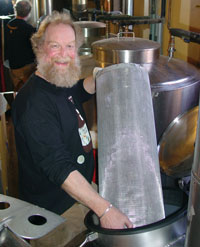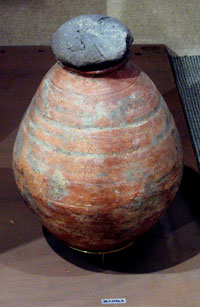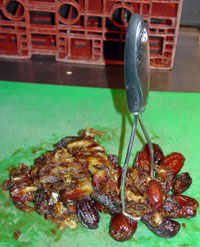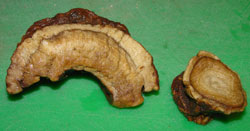
It all started in mid-August 2011 with an email from the Hood Museum of Art at Dartmouth College in Hanover, N.H., asking me if I would give a presentation about ancient Egyptian beer-making in April 2012. The museum had an Egyptian exhibit called Egyptian Antiquities at Dartmouth: Highlights from the Hood Museum of Art, curated by Dr. Christine Lilyquist, a former curator of Egyptian art at the Metropolitan Museum of Art in New York. The event was organized to highlight an unusual piece in the museum’s collection, a fully intact, alleged “beer jar” dating from 2300 B.C., the time of the Old Kingdom (roughly 2575-2100 BC). I had been reading and writing a bit about brewing in antiquity, so I accepted the offer and suggested that, as an added touch, perhaps I should replicate a Pharaonic brew and serve it at the event. Happily, I was able to find two collaborators for such a project: Peter Egelston, owner of the Portsmouth Brewery, and Tod Mott, that brewpub’s then-head brewer. None of us, however, had a complete picture of what we were getting ourselves into!
E gyptologists have found many jars shaped like the one in the Hood Museum, and they have always called them “beer jars.” However, the jar at Dartmouth had an inexplicable hole in the bottom, which the ancient potter had apparently put there deliberately. This obviously put the jar’s suitability as a drinking vessel into question. My inquiry about the function of the hole, therefore, led curator Lilyquist to embark on a quest for an answer among her Egyptologist colleagues. The surprising solution to the puzzle was provided by a Polish archaeologist, Dr. Teodozja Rzeuska, of the University of Warsaw. In one of her recent digs in a necropolis from the Old Kingdom, Dr. Rzeuska had discovered an array of several dozen jars with such holes. Subsequent analyses determined that these jars were never used for beer. Instead, they were ritual containers for the botanical remains of burned funeral offerings, the meaning of which is not fully understood. Only vessels without holes were, indeed, beer jars. By the time this piece of archaeological re-interpretation surfaced, however, my presentation had already been advertised and it would have been difficult to cancel the event. Thus, we let the show go on and made the beer.
gyptologists have found many jars shaped like the one in the Hood Museum, and they have always called them “beer jars.” However, the jar at Dartmouth had an inexplicable hole in the bottom, which the ancient potter had apparently put there deliberately. This obviously put the jar’s suitability as a drinking vessel into question. My inquiry about the function of the hole, therefore, led curator Lilyquist to embark on a quest for an answer among her Egyptologist colleagues. The surprising solution to the puzzle was provided by a Polish archaeologist, Dr. Teodozja Rzeuska, of the University of Warsaw. In one of her recent digs in a necropolis from the Old Kingdom, Dr. Rzeuska had discovered an array of several dozen jars with such holes. Subsequent analyses determined that these jars were never used for beer. Instead, they were ritual containers for the botanical remains of burned funeral offerings, the meaning of which is not fully understood. Only vessels without holes were, indeed, beer jars. By the time this piece of archaeological re-interpretation surfaced, however, my presentation had already been advertised and it would have been difficult to cancel the event. Thus, we let the show go on and made the beer.
Beer-Making in Ancient Egypt
First, some research was required. There are several great works on ancient brewing. Most notable among them are, perhaps, Uncorking the Past by Patrick McGovern (who has worked extensively with Dogfish Head Craft Brewery on its Ancient Ales series of beers), and the first few chapters of A History of Beer and Brewing by Ian Hornsey. But even these eminent scholars ultimately conclude that the evidence about ancient brewing ingredients and techniques is ambiguous and that we simply do not know for sure every detail required to replicate them authentically. The first job for brewing the beer, therefore, was to nail down a recipe—that is, to pick one of several possible sets of instructions and run with it. To me, the clearest and most interesting recipe I could find was in a German book, Bier jenseits von Hopfen und Malz (Beer beyond Hops and Malt) by Christian Rätsch. It contained a reprint of a recipe first published in 1926 by E. Huber in an essay titled “Bier und Bierbereitung bei den Ägyptern” (Beer and Beer Preparation among the Egyptians). This recipe was for a brew that might have been made sometime between 2575 and 1070 B.C.
Based on current scholarly writings, the ancient Egyptians appear to have distinguished between different beers by their alcoholic strength, color, and dominant flavor. We would probably call these beer categories “styles” nowadays. The most favored beer styles in ancient Egypt apparently were blood red in color. Pharaonic brews generally started out in a bakery, where the brewers or brewsters would thresh and winnow the grain and sift it through sieves made of rushes. Then they would grind the grain using mortars and pestles. Next, they would work the coarse flour into bread dough, from which they would form bell-shaped moist loaves called cyllestis. These they baked in beehive-shaped ovens. Essentially, such bread-making must have been the functional equivalent of our modern malting, with the oven playing the part of the malt kiln. Once the Egyptians removed the loaves from the oven, each loaf would be divided into quarters and soaked in water, apparently three cut-up loaves to one crock.
This must have been the point in the process when—unbeknownst to the ancient brewers and brewsters, of course—grain enzymes converted starches to sugars, and airborne yeast settled into the mush to ferment the sugars into alcohol. Importantly, there are conflicting reports on whether the loaves for the “mash” were baked from partially malted grains that had already started to sprout—in which case the grain enzymes would have been well-activated—or if they were baked from un-germinated grains—in which case enzymatic activity would have been much poorer and the resulting brews would probably be less alcoholic.
According to Rätsch, the ancient Egyptians often fortified their brews with dates and honey and flavored them with herbs and spices. Hops were not known to them! We do not know at which stage the adjuncts and flavorings were added to the brew, but the “fermentation” stage appears to be the most likely step in the process. Once the mush was fermented, the brewers or brewsters transferred it into casks and further macerated it by stomping it with their feet or large pestles. Next, they placed the macerated gruel into hollows, where they thinned it out with additional water, and allowed it to rest. We can presume that some “secondary fermentation” must have taken place as well.
The now fairly thin “mash” was then passed through a type of strainer, which we might call a “lauter tun” in modern terminology. There, the brew was rinsed with additional “sparge” water, and the collected run-off was allowed to rest in crocks, probably for some final sedimentation. Eventually, the finished beer was placed in new crocks, which were sealed with clay cones or flat lids that were strapped airtight to the crocks’ openings. These “lagering” crocks were kept in cellars, maybe even buried, to mellow the brew before consumption. The spent grain from beer making, incidentally, was saved as food.
Modern Improvisation
When Tod and I brewed our Pharaoh Ale, we had to make two major decisions right from the start. First was a need to come up with appropriate equivalents for the heirloom raw materials the ancient Egyptians are known to have put into their brews. Second, we had to figure out how to translate ancient Egyptian brewing techniques into a process that would work with modern brew equipment while still yielding reasonably authentic results. We immediately agreed not to replicate the ancient bread-technique for malting and mashing, because we simply lacked the facilities to do so. Instead, we picked ingredients that would allow us to perhaps achieve the same flavor, mouthfeel, and color effects of the ancient bread brews, but by using malted grain as well as a single-infusion mash process that was suitable for the pub’s brewhouse. This process is also easy to copy for a homebrew.
An ancient Egyptian bread grain-bill usually consisted, as best as anyone can tell, of such heirloom wheat varieties as emmer and spelt (dinkel), as well as barley—either separately or in combination. This posed a problem for our mash, because malted emmer is next to impossible to come by nowadays, and our modern wheat and barley varieties are definitely very different from their ancient progenitors. In addition, we were not able to find any reliable information on the relative proportions of these grains. However, given that the land of the Nile was frequently visited by droughts and bad harvests, which caused certain crops to become scarce or completely unavailable at times, there must have been many grain bill variations over the many centuries the ancient Egyptians brewed their beers. Thus, we felt comfortable taking some educated and defensible (we hope!) guesses for our reproduction at Portsmouth.
For spelt, we used pale and chocolate spelt (dinkel) malts from Weyermann® at roughly 15.5 and 0.5 percent of the mash, respectively. For base malts, we chose floor malts, which we hoped would give us an “older” flavor than perfectly modified malts made the modern way. We picked floor-malted Pilsner and wheat malt at roughly 46.5 and 23.3 percent of the mash, respectively. For some breadiness, we added 0.5 percent melanoidin malt to the mash. Finally, for color, flavor, and body, we added Carared® (approx. 7 percent of the mash), Carawheat® (4.8 percent), Carafa® II de-husked roasted malt (0.5 percent), chocolate wheat malt (0.5 percent), and Carafa® III de-husked roasted malt (0.5 percent). To state the mash composition another way, 55.86 percent of our grist was barley malt, 28.07 percent was wheat malt, and 16.07 percent was spelt malt. This gave us 85.32 percent of enzyme-rich malts and 14.68 percent of color malts. The color value of our brew was about 12 SRM (30.7 EBC). Other brewers might have composed a different grain bill, probably with no lesser claim to authenticity than ours.
 Also, because we wanted to make sure that the beer was drinkable for the attendants of the lecture at the Hood Museum and for the patrons of the brewpub, we decided to thoroughly sterilize it and evaporate off-flavor volatiles (such as DMS) through a conventional boil. This allowed us to add all flavors and adjuncts to the kettle instead of to a fermentation mush. In line with Egyptian practice, we also added dates and honey to the brew for extra sugars and thus alcohol. Again, we had only vague information about the correct quantities, so we took another guess. We used approximately 4 pounds (1.81 kg) of hand-macerated dates, with pits, and 3.7 pounds (1.67 kg) of honey per barrel. This translates into roughly 10.3 ounces (292 grams) of dates and 9.5 ounces (269 grams) of honey for a five-gallon (19-liter) homebrew batch.
Also, because we wanted to make sure that the beer was drinkable for the attendants of the lecture at the Hood Museum and for the patrons of the brewpub, we decided to thoroughly sterilize it and evaporate off-flavor volatiles (such as DMS) through a conventional boil. This allowed us to add all flavors and adjuncts to the kettle instead of to a fermentation mush. In line with Egyptian practice, we also added dates and honey to the brew for extra sugars and thus alcohol. Again, we had only vague information about the correct quantities, so we took another guess. We used approximately 4 pounds (1.81 kg) of hand-macerated dates, with pits, and 3.7 pounds (1.67 kg) of honey per barrel. This translates into roughly 10.3 ounces (292 grams) of dates and 9.5 ounces (269 grams) of honey for a five-gallon (19-liter) homebrew batch.
Both adjuncts were added after about one hour into a 90-minute boil. We laboriously macerated the dates by hand with a potato masher, placed the pulp into a large cylindrical strainer, and lowered it into the boiling wort from a chain. For a five-gallon batch, a homebrewer’s muslin steeping bag might serve the same purpose. At the end of the boil, the date mass had been substantially reduced, a clear indication that all the date sugars had been dissolved into the wort.
Instead of flavoring our replica with anachronistic hops, we followed the ancient Egyptian custom of using ginger and mandrake root. Again, we had to guess the quantities: We used 2 pounds of ginger root per barrel, cut up in slices and added to the kettle in two increments. This amounts to roughly 0.7 ounces (20 grams) of ginger root for a homebrew batch. We lowered one-quarter of the ginger in a bag into the kettle near the start of the boil, and the remaining three-quarters in a bag about 10 minutes before shutdown.
 Mandrake roots can be ordered online. [Editor’s Note: Mandrake, a member of the nightshade family, should be used with great care. Even with such a small amount of mandrake added, beers made with this plant should not be consumed in large quantities or frequently.] We purchased 342 grams (12 ounces) of dried mandrake root from a specialty vendor. This amounts to about 46 grams (1.62 ounce) per barrel or roughly 7.5 grams (0.26 ounce) per five gallons. The mandrake roots were as hard as rocks when they arrived. We ground them up in a coffee grinder, then boiled them in water for about an hour. We then strained the mandrake tea through a steeping bag. Mandrake tea has a faint smell of porcini or boletus mushrooms, with a whiff of fenugreek and cardamom. The tea was oddly aromatic, and the taste distantly resembles marzipan. We added half the tea to the kettle near the start of the boil. We added the rest when we hung the second bag of ginger root, as well as a bag with the mandrake residue, in the kettle about 10 minutes before shutdown.
Mandrake roots can be ordered online. [Editor’s Note: Mandrake, a member of the nightshade family, should be used with great care. Even with such a small amount of mandrake added, beers made with this plant should not be consumed in large quantities or frequently.] We purchased 342 grams (12 ounces) of dried mandrake root from a specialty vendor. This amounts to about 46 grams (1.62 ounce) per barrel or roughly 7.5 grams (0.26 ounce) per five gallons. The mandrake roots were as hard as rocks when they arrived. We ground them up in a coffee grinder, then boiled them in water for about an hour. We then strained the mandrake tea through a steeping bag. Mandrake tea has a faint smell of porcini or boletus mushrooms, with a whiff of fenugreek and cardamom. The tea was oddly aromatic, and the taste distantly resembles marzipan. We added half the tea to the kettle near the start of the boil. We added the rest when we hung the second bag of ginger root, as well as a bag with the mandrake residue, in the kettle about 10 minutes before shutdown.
After the boil, we treated our Pharaoh Ale like any other beer. We whirlpooled it, heat-exchanged it, then pitched it with freshly drawn “Chico”-type ale yeast. More experimental brewers could try fermenting the wort with a combination of brewers yeasts plus, perhaps, wild yeasts and/or microbes. The original gravity of our wort before the addition of adjuncts was 10.5 °P (OG 1.042). The original gravity in the tank was 11.1 °P (OG 1.045). The final gravity was a dry 2.5 °P (FG 1.010), and the finished brew’s alcohol by volume was roughly 4.5 percent. We calculated the combined contribution of these adjuncts to alcohol in the finished beer to be about 0.25 percent by volume.
Tasting Notes
The Pharaoh ale tasted unlike any other brew, in part because our modern palates have become so accustomed to the presence of hops. The brew has a minimal but fresh and appetizing bouquet. Visually, it is slightly turbid, and the color is deep reddish amber to almost light mahogany. The up-front taste shows mild notes of nuttiness (probably from the dates), with a faint scent of rose petals and perhaps of almond extract—probably a contribution from the mandrake root tea. The body is medium. As the brew spreads over the palate, strong malty notes as well as a definite date and honey aroma take over, which is especially noticeable because of the absence of any hop bitterness. This is a surprise but not an obstacle. The brew also takes on mild, lingering herb-like notes, which only serve to enhance its drinkability.
We decided, as a concession to modern tastes, to mildly carbonate the brew with CO2 for some effervescence that would enhance the gentle character of the beer, even though in ancient Egypt, we suppose, carbonation must have been very low to non-existent. A homebrewer might want to use standard priming procedures for packaging this brew. Because the adjuncts are completely fermented, there is no residual sweetness in the brew even though the starting wort tasted strongly syrup-like. The beer finishes with indefinable, subtle aromatics that seem unique to our taste buds. These notes are more interesting because of the brew’s dryness.
The overall impression the brew leaves behind is that of a very clean-tasting, refreshing, dry, medium-body, drinkable, and highly balanced quaffing beer.
Horst Dornbusch is an international brew industry consultant and a multi-lingual author of books and articles about beer. He especially enjoys creating and brewing unusual beers with friends all over the world and writing about his brewhouse experiences. A version of this article originally appeared in the November/December 2012 issue of The New Brewer. The Hood Museum can be found at www.hoodmuseum.dartmouth.edu.
Pharaoh Ale
Ingredients for 5 U.S. gallons (19 liters):
- 3.75 lb (1.7 kg) Weyermann® Bohemian Pilsner floor malt
- 1.63 lb (739 g) Weyermann® Bohemian wheat floor malt
- 1.09 lb (494 g) spelt malt
- 0.49 lb (222 g) Carared®
- 0.34 lb (154 g) Carawheat®
- 0.64 oz (18 g) melanoidin malt
- 0.64 oz (18 g) Carafa® Special Type II
- 0.64 oz (18 g) chocolate wheat malt
- 0.64 oz (18 g) chocolate spelt malt
- 0.64 oz (18 g) Carafa® Special Type III
- 10.33 oz (292 g) dates (with pits)
- 9.55 oz (270 g) honey
- 0.7 oz (19 g) ginger root
- 0.25 oz (7 g) mandrake root*
- Any clean-fermenting ale yeast
*Editor’s Note: Mandrake, a member of the nightshade family, should be used with great care. Even with such a small amount of mandrake added, beers made with this plant should not be consumed in large quantities or frequently.
- Original Gravity: 1.045 (11.1 P)
- SRM: 12.04
- ABV: 4.5 percent
Directions
For information on adding the dates, honey, ginger, and mandrake root to the beer, see the article text. Mash in for a mash temperature of 154-156 °F (approx. 68 °C). Rest mash for 60 minutes. Recirculate for 10 minutes. Sparge slowly with 167 °F (75 °C) water for two hours. Boil for 90 minutes. Ten minutes into the boil, pour half of the mandrake tea into the wort and lower one-quarter of the sliced ginger root in a bag into the wort. Sixty minutes into the boil, pour second half of the mandrake tea into the wort, lower the remaining three-quarters of the sliced ginger root in a bag into the wort, lower the spent mandrakes in a bag into the boil, and lower the macerated dates in a steeping bag into the boil. At shutdown, rest wort for 10 minutes. Whirlpool for 30 minutes. Heat-exchange, ferment, and package the brew like a normal ale.
Mandrake, Eros, and the Place of Beer in Ancient Egyptian Society
Mandrake (Atropa mandragora or Mandragora officinarum) means “dragon mind” [from Latin mens = mind; dragora = dragon]. It is a perennial, alkaloid-containing, slightly hallucinogenic member of the nightshade family. Other alkaloid-containing nightshades include potatoes, tomatoes, eggplants, and most peppers. Condiments made from peppers, such as Tabasco sauce or paprika, contain alkaloids, too. Cooking usually reduces the alkaloid content of vegetables by about 50 percent. For our brew, we made a tea of ground mandrake root. Once added to the kettle, it gave the brew the equivalent of perhaps one-and-a-half drops of Tabasco sauce per one gallon of chili.In antiquity, mandrakes featured prominently in literature, mostly because they were regarded as an aphrodisiac. In Homer’s Odyssey, for instance, Circe handed out mandrake wine to Odysseus and his crew to disorient them. Even in the Bible, mandrakes were bartered for connubial favors, as in Genesis, Book 30, 14-17.In ancient Egypt, mandrake root was known as the “phallus of the field.” It was often presented as a gift of love during courtship, and as an invitation to intimacy. Mandrakes were connected to the goddess Hathor. Both she and her bearded father Osiris were the patron deities of beer. While Osiris was also the god of the dead, Hathor was also the goddess of love, beauty, dance, fertility, and birth—as well as the quintessential embodiment of an irresistible temptress. According to Egyptian mythology, Osiris had many dalliances with his own daughter. She even bore him a son, Horus.In Hathor’s temples, beer was the sacrificial drink of choice. Priestesses and temple maidens would give banquets for worshippers, during which the ladies performed erotic dances. Each dancer, dressed only in a string around her waist, as unclad as Hathor had shown herself to her father, would move her hips enticingly before the guests. Hollow pearls, filled with pebbles and suspended from the dancer’s waist band, would amplify the arousing rhythm of the erotic spectacle. As the alcohol took over, Hathor’s beer would put the imbibers in direct contact with the world beyond, creating a link between the heavens and the earth and allowing people to partake in the mystery of life and death. Fittingly, the dead, too, were supplied with crocks of beer in their tombs so that they would not be thirsty on their trip to the realm where Hathor and Osiris were waiting for them…with crocks of beer, of course.


Share Post